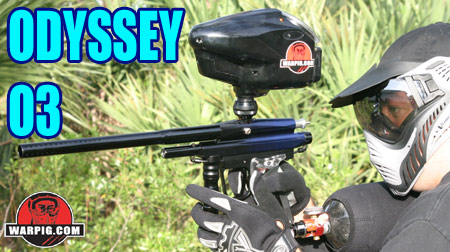
Odyssey O3
By Bill Mills - Nov 2004
Velocity
Data Target
Groupings
Odyssey Paintball made a name for themselves
with the HALO loader. At the start of the 2004 tournament season,
the company made their first trade show appearance under their new name
of Odyssey Group International, a company formed by the merger of Odyssey
and Dragun Empire. Dragun Empire made their mark in the sport first
with the Black Dragun, a low cost blowback semi-auto with an electro mechanical
trigger and sear.
In addition to upgrade kits for other
paintguns, OGI showed the 03. While the receiver of the 03 is light
and compact, looking a lot like many stacked tube blowback semi designs,
the marker is a true electropneumatic.
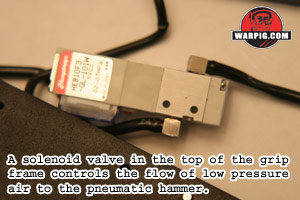 Rather
than using a solenoid to trip the sear of a blowback hammer and valve system,
the O3 uses a low pressure gas source controlled by a compact solenoid
valve to drive a pneumatic hammer against the paintgunís popet style exhaust
valve. Rather
than using a solenoid to trip the sear of a blowback hammer and valve system,
the O3 uses a low pressure gas source controlled by a compact solenoid
valve to drive a pneumatic hammer against the paintgunís popet style exhaust
valve.
Flush mounted to the O3ís grip frame
is an inline regulator. With an ASA in the rear, the regulator accepts
either a CO2 or HPA screw in style tank directly and regulates the gas
down to around 225 to 300 psi, the operating range of the 03. Left
and right side output ports and an additional port on the bottom allow
the O3ís macroline to be configured to the userís taste. In stock
configuration, the macroline runs on the right side, and a micro gauge
on the left, in an easy position to be read while on the field.
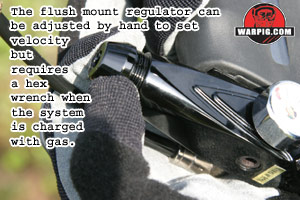 The
regulator is adjusted by a knob on its front. Velocity adjustment
is achieved by setting the supply gas pressure on the main regulator.
Increasing the pressure increases velocity, while decreasing drops it down.
The adjustment knob is easily turned by hand when it is not under pressure,
or with a hex wrench in its front when the system is under pressure.
Because the stock regulator can be adjusted without tools, it must be replaced
if the 03 owner plans to compete in a tournament using the NPPL (rule 11.04)
or PSP (rule 3.6) rule sets. The O3 is well equipped to receive aftermarket
regulators. The regulator attaches to the grip frame by sliding onto
an integrated ¾ inch dovetail rail, the type used on high-end adjustable
output compressed air systems. Changing the regulator can be a bit
of a chore though, as it requires removing the electronics from the grip
frame to access a lock screw. Installing a tourney lock screw on
the stock regulator would be a simple job for an experienced airsmith. The
regulator is adjusted by a knob on its front. Velocity adjustment
is achieved by setting the supply gas pressure on the main regulator.
Increasing the pressure increases velocity, while decreasing drops it down.
The adjustment knob is easily turned by hand when it is not under pressure,
or with a hex wrench in its front when the system is under pressure.
Because the stock regulator can be adjusted without tools, it must be replaced
if the 03 owner plans to compete in a tournament using the NPPL (rule 11.04)
or PSP (rule 3.6) rule sets. The O3 is well equipped to receive aftermarket
regulators. The regulator attaches to the grip frame by sliding onto
an integrated ¾ inch dovetail rail, the type used on high-end adjustable
output compressed air systems. Changing the regulator can be a bit
of a chore though, as it requires removing the electronics from the grip
frame to access a lock screw. Installing a tourney lock screw on
the stock regulator would be a simple job for an experienced airsmith.
From the regulator, gas passes through
the included macroline to a gas through grip which, as mentioned previously
can be replaced with a vertical regulator as an alternative configuration.
Through the vertical ASA, gas feeds directly to the 03ís valve chamber.
The exhaust valve is laid out similar to that of a Spyder, Illustrator
or Piranha. When struck from the rear, it vents gas into the upper
half of the receiver where the bolt directs it to the breech.
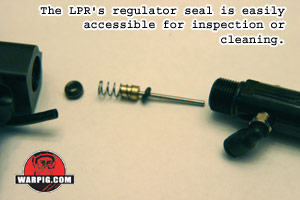 On
the front end of the valve chamber, where many blowback semis have a low
pressure valve chamber, the 03 has a compact low pressure regulator.
This regulator is adjustable, and serves the purpose of limiting the pressure
that is fed to the 03ís solenoid valve. On
the front end of the valve chamber, where many blowback semis have a low
pressure valve chamber, the 03 has a compact low pressure regulator.
This regulator is adjustable, and serves the purpose of limiting the pressure
that is fed to the 03ís solenoid valve.
Low pressure pneumatics hose runs from
the low pressure regulator into the top of the grip frame, where the solenoid
valve is housed. This electronically actuated valve cannot handle
the pressure or volume of gas needed to propel a paintball directly.
Instead it drives the pneumatic hammer when actuated by the 03ís electronic
circuit board.
A single gas line runs from the solenoid
valve to an end-cap on the rear of the 03. Both the rear end cap,
and the low pressure regulator are fitted with quick release swivel fittings
which makes removing the low pressure hose a simple task when disassembling
the Ďgun for maintenance or repair.
On blowback powered stacked tube semi-autos,
the hammer is in the lower receiver. It is normally held back by
the sear. When the trigger moves the sear and releases the hammer,
a mainspring drives the hammer against the valve, causing it to open.
A small amount of gas is diverted toward the hammer, pushing it back and
re-cocking the mainspring.
 The
03 places a spring on the opposite side of the hammer. There is no
sear in its design, and no mainspring to drive the hammer forward.
Instead, the back of the hammer is a cylinder which fits inside the rear
end cap, forming a pneumatic ram. When the solenoid valve feeds low
pressure gas to the end cap, the gas fires the hammer forward, causing
it to strike the exhaust valve. The hammerís spring then returns
the hammer to its rear position, readying it for the next shot. The
03 places a spring on the opposite side of the hammer. There is no
sear in its design, and no mainspring to drive the hammer forward.
Instead, the back of the hammer is a cylinder which fits inside the rear
end cap, forming a pneumatic ram. When the solenoid valve feeds low
pressure gas to the end cap, the gas fires the hammer forward, causing
it to strike the exhaust valve. The hammerís spring then returns
the hammer to its rear position, readying it for the next shot.
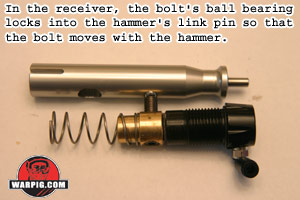 Odyssey
calls this hammer system FASOR, an acronym for Forward Aired Spring Operated
Return. Because the gas is only used to drive the hammer forward,
only a single hose is needed between the solenoid valve and end cap.
This makes the 03 less mechanically complex, and allows it to use a simpler
solenoid valve than electropneumatic designs which use air pressure to
both drive and reset the hammer. Odyssey
calls this hammer system FASOR, an acronym for Forward Aired Spring Operated
Return. Because the gas is only used to drive the hammer forward,
only a single hose is needed between the solenoid valve and end cap.
This makes the 03 less mechanically complex, and allows it to use a simpler
solenoid valve than electropneumatic designs which use air pressure to
both drive and reset the hammer.
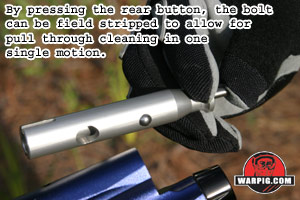 In
the upper tube of the receiver lies the bolt. The 03ís bolt has an
open interior high flow design. Its rear extends out the receiverís
back when at rest, showing its quick strip push button. Depressing
this button allows a ball bearing in the boltís middle to retract so the
bolt can be field stripped in one simple motion. The ball bearing,
while extended links the bolt to the hammer, so that it chambers a ball
and closes the breech when the 03 is fired. In
the upper tube of the receiver lies the bolt. The 03ís bolt has an
open interior high flow design. Its rear extends out the receiverís
back when at rest, showing its quick strip push button. Depressing
this button allows a ball bearing in the boltís middle to retract so the
bolt can be field stripped in one simple motion. The ball bearing,
while extended links the bolt to the hammer, so that it chambers a ball
and closes the breech when the 03 is fired.
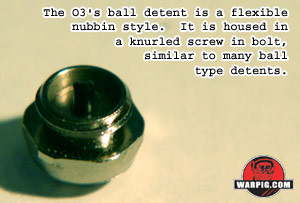 On
the left side of the receiver is a simple rubber nubbin style ball detent
housed under a knurled aluminum cap. The detent extends into the
breech area to prevent paintballs from double-feeding. Atop the receiver
is a low-profile clamping feed neck. On
the left side of the receiver is a simple rubber nubbin style ball detent
housed under a knurled aluminum cap. The detent extends into the
breech area to prevent paintballs from double-feeding. Atop the receiver
is a low-profile clamping feed neck.
Odyssey designed the 03 to work optimally
with their HALO loader which does not require a gap in the ball stack to
activate. This means that it can work effectively with a very short
feedneck, creating a smaller profile for the player.
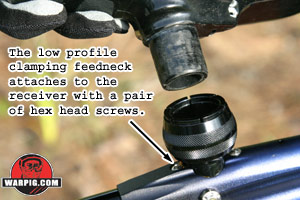 The
feedneck attaches with a pair of hex head screws one in front, and one
in the rear. This makes it simpler to change or remove for cleaning
when compared to designs which rely on press fit and adhesives, or threading
and adhesives. The
feedneck attaches with a pair of hex head screws one in front, and one
in the rear. This makes it simpler to change or remove for cleaning
when compared to designs which rely on press fit and adhesives, or threading
and adhesives.
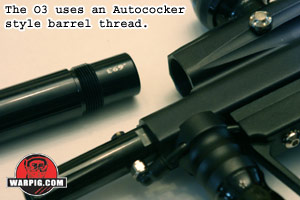 The
03 receiver is threaded with Autococker style barrel threads. The
stock barrel is fourteen inches in length, with porting along its last
four and a half inches. Both the interior and exterior are highly
polished and anodized. The stock barrel is also laser engraved to
indicate that it features a .693 inch bore diameter. The
03 receiver is threaded with Autococker style barrel threads. The
stock barrel is fourteen inches in length, with porting along its last
four and a half inches. Both the interior and exterior are highly
polished and anodized. The stock barrel is also laser engraved to
indicate that it features a .693 inch bore diameter.
 The
03 features a blade style two finger trigger. There is no trigger
return spring, instead the design relies on the resistance of the internal
microswitch to return the trigger to its forward position. Two trigger
adjustments allow the trigger to be fine tuned. One adjusts the trigger
activation point, by screwing through the trigger against the microswitch
lever, and the other limits the forward travel of the trigger by adjusting
its contact point with the grip frame. The trigger pivots on a steel
pin that is press fit into the trigger frame, and has a small amount of
side to side play. The
03 features a blade style two finger trigger. There is no trigger
return spring, instead the design relies on the resistance of the internal
microswitch to return the trigger to its forward position. Two trigger
adjustments allow the trigger to be fine tuned. One adjusts the trigger
activation point, by screwing through the trigger against the microswitch
lever, and the other limits the forward travel of the trigger by adjusting
its contact point with the grip frame. The trigger pivots on a steel
pin that is press fit into the trigger frame, and has a small amount of
side to side play.
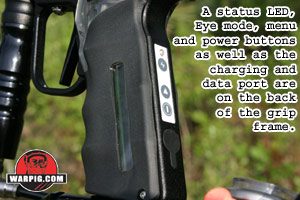 At
the heart of the 03 is its electronics package. Inside the lower
portion of the grip frame lies the main circuit board, a sub-board with
a backlit LCD display and a six cell rechargeable battery. The LCD
display is visible through a window in the 03ís wraparound panel grips.
On the rear of the grip frame is a status LED, three membrane buttons,
and the charging socket, which is protected from debris by a small rubber
cap which features a short retaining leash so that it will not be dropped
and lost. At
the heart of the 03 is its electronics package. Inside the lower
portion of the grip frame lies the main circuit board, a sub-board with
a backlit LCD display and a six cell rechargeable battery. The LCD
display is visible through a window in the 03ís wraparound panel grips.
On the rear of the grip frame is a status LED, three membrane buttons,
and the charging socket, which is protected from debris by a small rubber
cap which features a short retaining leash so that it will not be dropped
and lost.
Continued on NEXT
PAGE |





